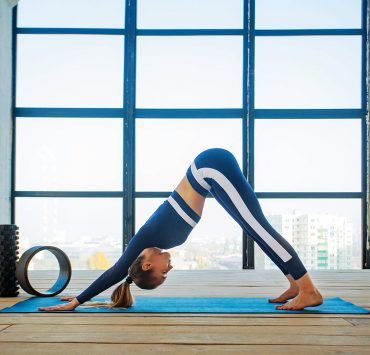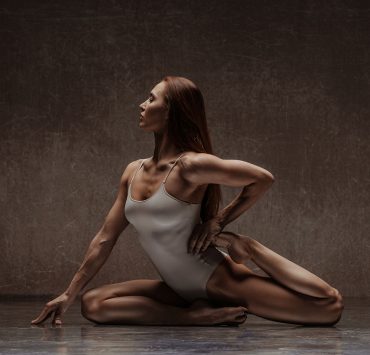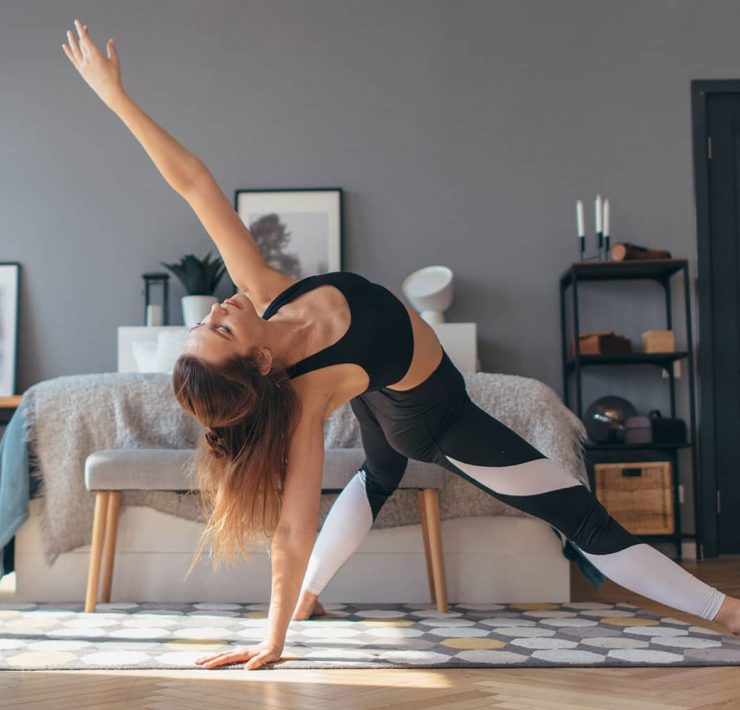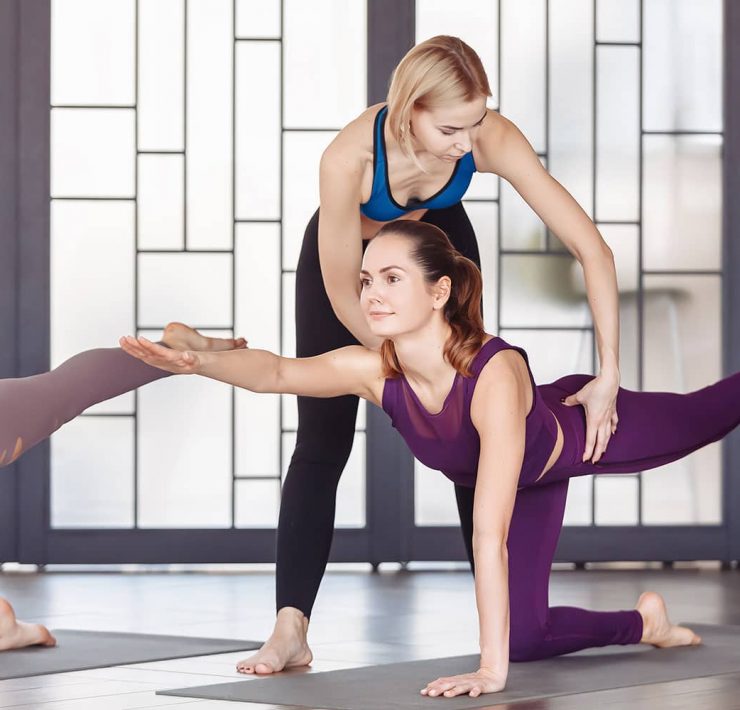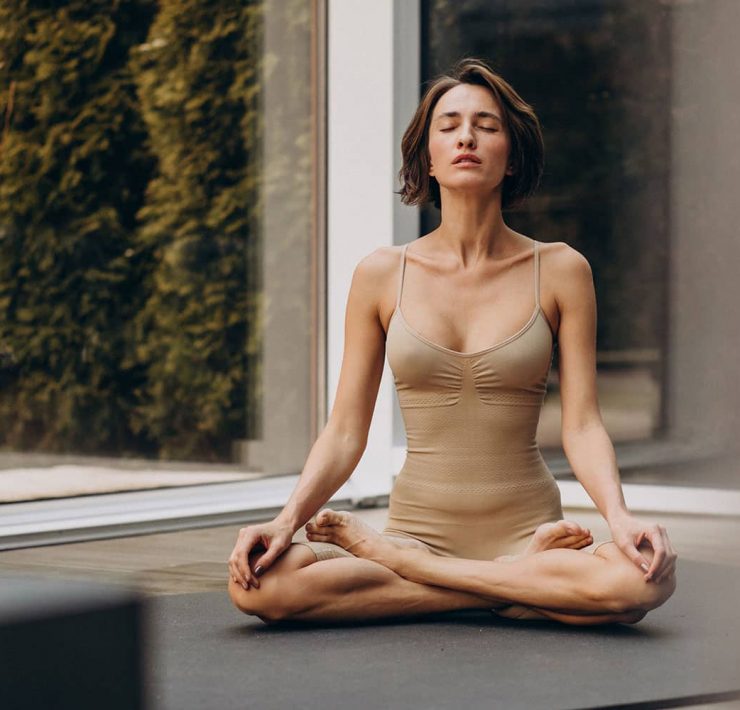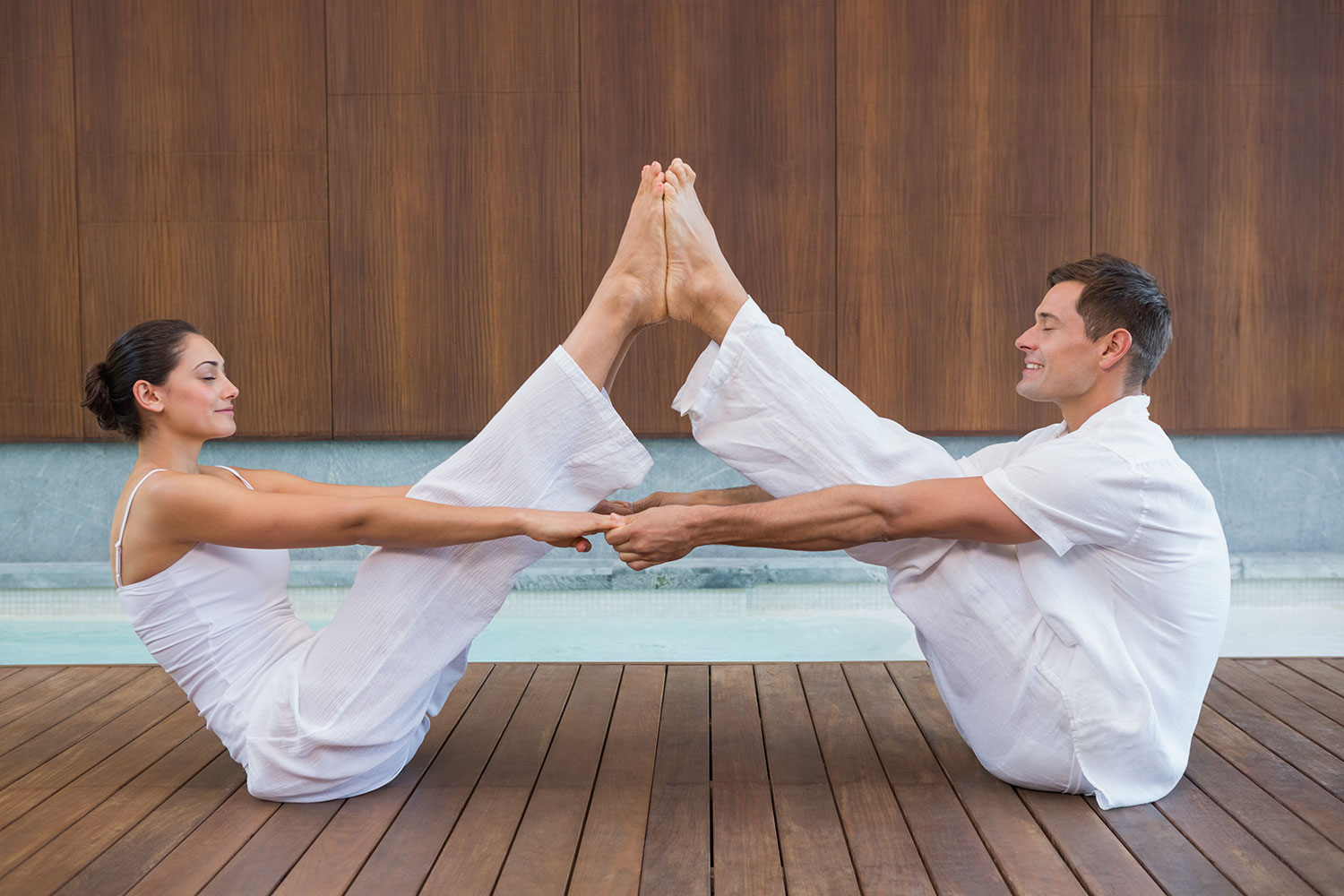
Susan views the world through a lens of spirituality, health,…
Yoga is usually a solo activity even when you are practicing with a group in a class. But partner yoga is becoming more popular, especially for couples, to build intimacy.
A regular yoga practice can help you find inner peace and clarity within yourself. So it makes sense that sharing this practice with a loved one can deepen and strengthen the bonds of your relationship.
But before you start lifting your partner up over your head with an acroyoga pose that may need guidance from a certified instructor, get experienced with some gentle asanas designed for couples yoga first.
Start with a few beginner-friendly poses to help you ease into a more meditative practice of yoga with a partner.
The Benefits of Partner Yoga
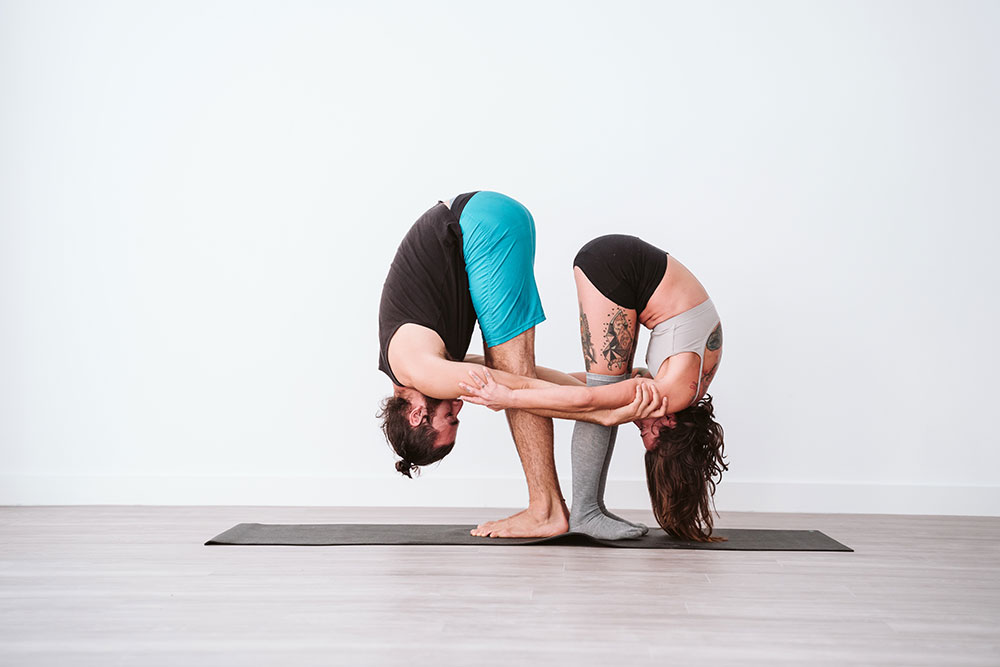
Yoga for couples supports a solo yoga practice because it requires all the same skills of mindfulness, awareness, and being present. This time, it’s not only with yourself and your own breath, but with your partner’s as well.
Practicing yoga as a pair will improve your communication skills and ability to place your trust in others, and yourself too!
The physical closeness required in partner yoga helps to develop authenticity between people. Yoga with a partner cultivates honesty both on and off the mat.
Partner yoga is a great activity for couples. Being close to each other, breathing and meditating together, and communicating clearly to each other helps develop intimacy.
The connection and intimacy fostered through partner yoga may not be for all couples in the beginning. But regularly practicing a few simple poses together may benefit any relationship and bring a whole new level of physical and emotional closeness.
Safety During Partner Yoga
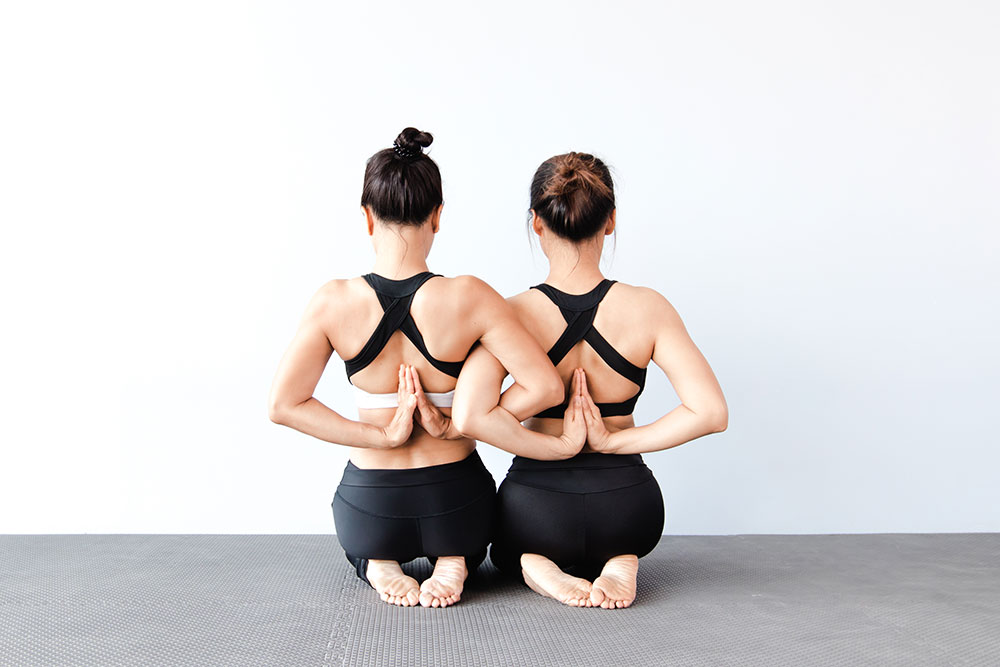
As with any relationship, especially intimate ones, communication is the key to success. In partner or couples yoga, communication is multi-layered.
Verbal communication expresses immediate concerns and cues during the poses. Meanwhile, non-verbal communication happens through touch, looking into each other’s eyes, and even breathing in unison (or not).
These are all important signs to be aware of when practicing partner yoga.
Even though you practice these poses as a pair, ultimately, you are responsible for your personal safety and comfort. Know your limits and capabilities, and express them clearly to your partner.
Also voice any concerns you have to the instructor if you are attending a group class. This will help you have a rewarding and fun partner yoga experience.
10 Easy Partner Yoga Poses for Intimacy
These are ten easy, beginner-friendly poses that you may practice together. They are simple enough whether one or both of you already have a regular yoga practice or are complete newbies.
It may help to place two yoga mats close beside each other on the floor to ensure you both have a space to practice.
Sukhasana – Easy Seated Pose
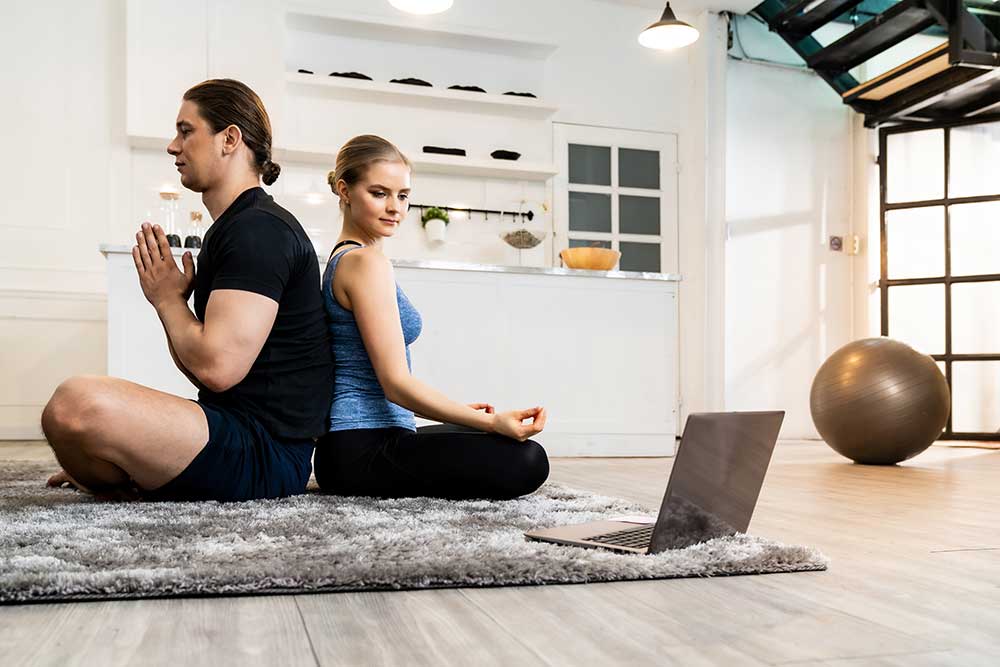
Begin this couple’s yoga practice with a simple, meditative pose that will help you both align with each others’ energies and intentions.
Get into Sukhasana, or Easy Seated Pose, by sitting on the floor with your back resting against your partner’s. Feel the support from your partner as you both lean against each other without overpowering one another.
Close your eyes and take deep, long breaths together. You may observe that your breaths will synchronize on their own.
Ardha Matsyendrāsana – Half Lord Of The Fishes Pose
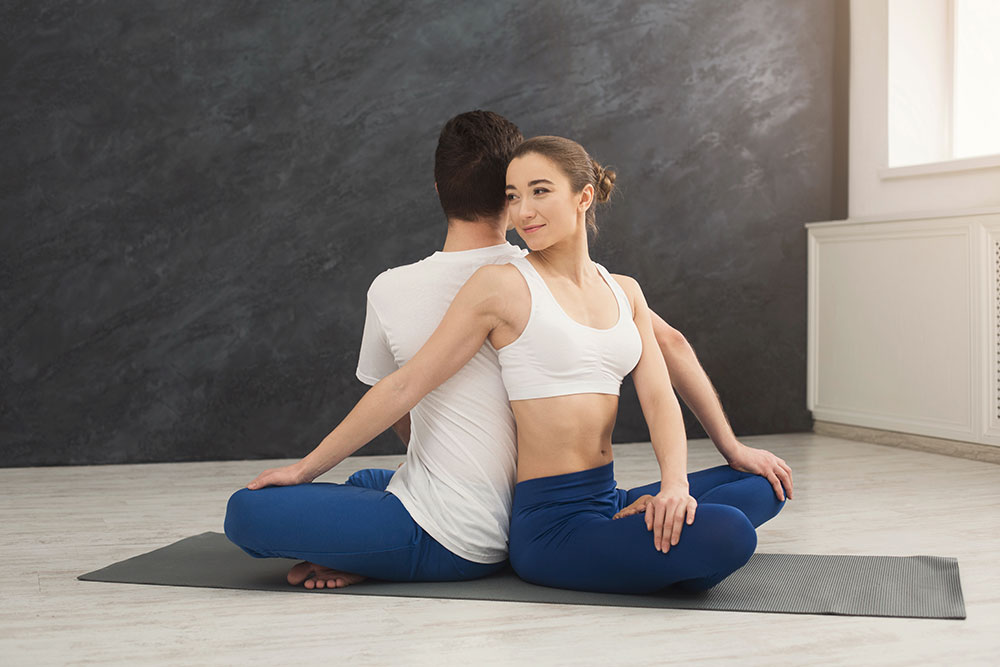
These partner twists are easy to transition into from Partner Breathing in Easy Seated Pose. Remain seated in Sukhasana with your backs against each other. Inhale and place your right hand on your left knee.
Exhale, and with your spine tall, twist towards the left, and reach your left hand to rest it on your partner’s right knee.
Take a few deep, long breaths in this side of the twist before releasing and do the same on the other side.
Badha Konasana – Partner Tailor Pose
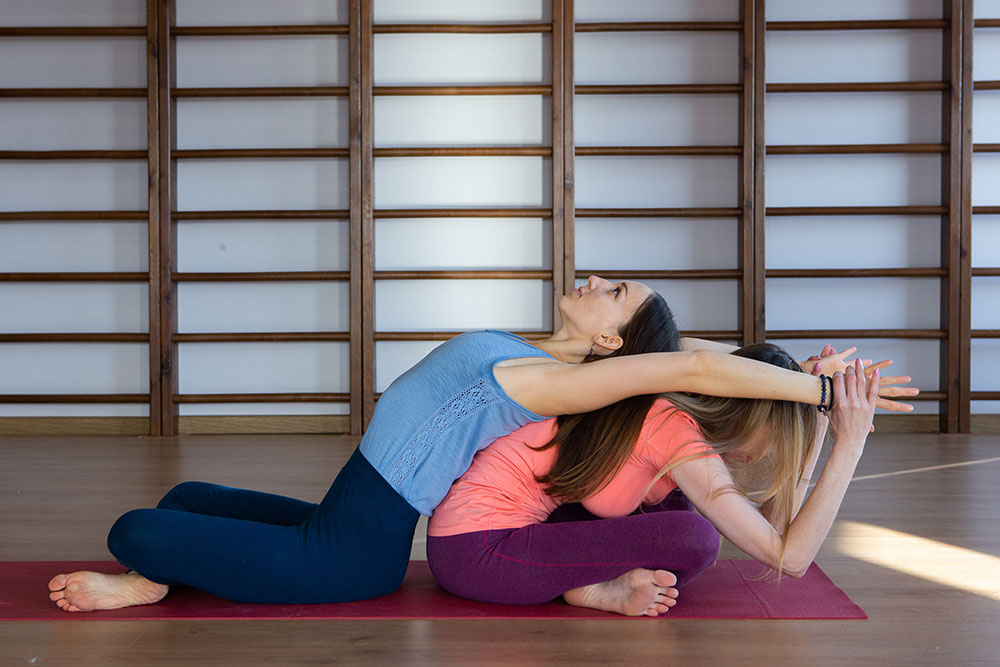
Shift your legs into Baddha Konasana, or Butterfly position with the soles of your feet together. Adjust the distance of your feet away from your groin to your flexibility and place support under your knees, if necessary.
Your partner can either do the same or place their feet on the floor. Inhale to lengthen your spine and exhale to fold forward.
As you do this, allow your partner to rest their back against yours to help deepen the fold to your comfort level.
Verbalize any discomfort or too much weight from your partner on your back as needed.
The weight should be enough to help deepen the pose, but not so much that your breathing becomes strained.
Stay in this pose for a few long, deep breaths and switch roles for the next round, being as mindful with your partner as you would wish them to be with you.
Partner Balasana and Matsyasana – Child’s Pose and Fish
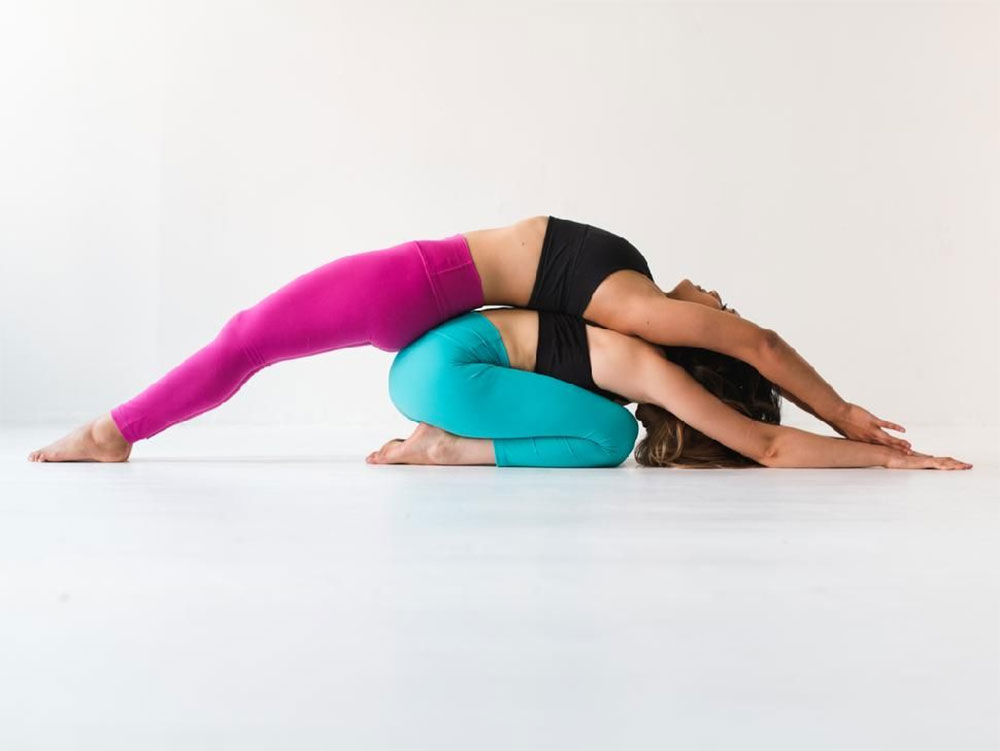
This set of asana will help deepen the forward and backbends from the previous poses.
Position yourself in Balasana, or Child’s Pose. A wide-knee version will help keep pressure off your chest and keep your breathing more free.
Like the last pose, your partner will lay their back onto yours. This time, they will extend their legs flat on the ground so that their entire upper body weight will be on yours.
As before, communicate any discomfort, difficulties with breathing, or sharp pain. At any moment, voice if you need to come out of the pose.
If you’re able to settle into both Child’s Pose and Supported Fish Pose, breathe together like this for a few moments. When you’re ready, release the pose and switch roles.
Upavistha Konasana – Seated Partner Wide-Legged Forward Fold
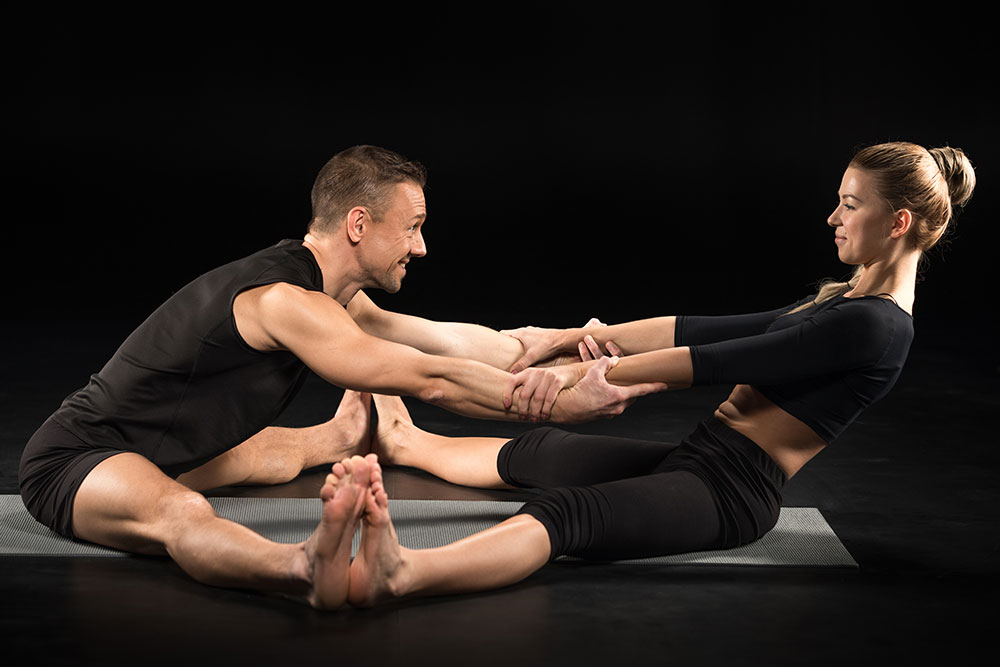
This pose is often practiced by gymnasts and competitive cheerleaders to help improve flexibility. As a partner yoga pose, it helps build trust and support in the relationship in addition to the physical benefits.
Face each other as you sit on the ground with enough space between you and your partner to separate your heels. Allow your partner to place the soles of their feet on your inner ankles to maintain the distance between them. If there is too much strain on your inner thighs, lessen the distance between your feet.
Hold your partner’s hands, or hold each other at your elbows if both your flexibility allows. Inhale and lengthen up your spines. As you both exhale, your partner will lean back, pulling you forward.
You will help your partner not lean back too far and your partner will help deepen your Upavistha Konasana, or Wide Angle Seated Forward Bend.
Stay in this pose, taking deep, long breaths together, for as long as comfortable for both of you. Switch roles after releasing.
Utkata Konasana – Temple Pose
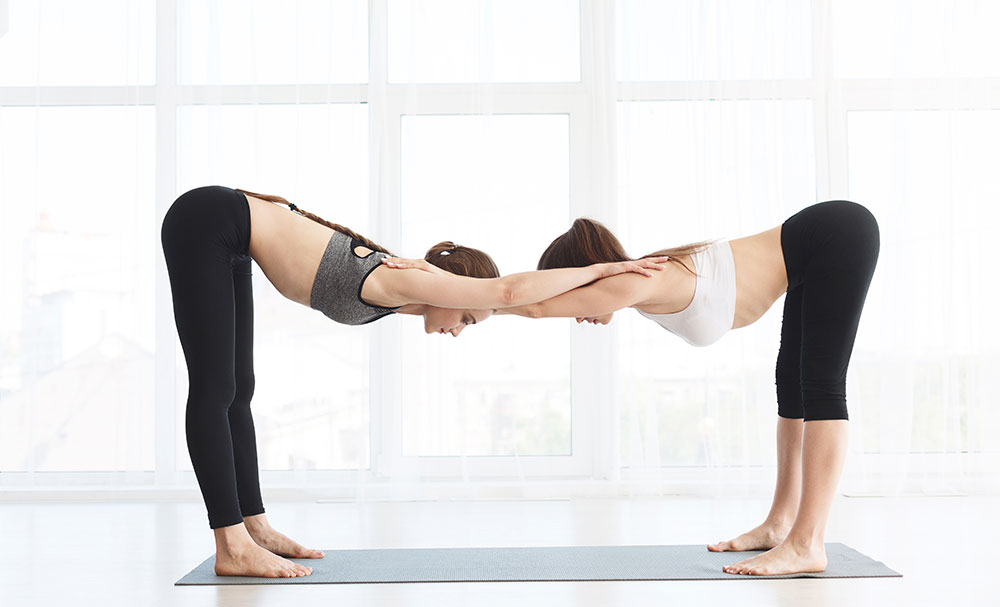
This first standing pose helps build intimacy, trust, and strength in each other as you can gaze into each other’s eyes while practicing the unconventional asana.
On a physical level, it opens up your shoulders, expands your chest, lengthens your spine, and strengthens your core.
Begin by standing up to face each other in Tadasana, or Mountain Pose. Stand far enough apart that you can do a half-forward fold without knocking on each other’s heads.
Inhale as you both raise your arms up above your heads to lengthen your spines. Exhale as you both hinge from your hips and begin to fold forward. Allow your arms to make contact, first by your palms facing each other, until your whole forearms touch.
Allow yourselves to lean equal weight on each other as much as is comfortable for you both. Release your chest and bellies to the floor. Your bodies will form the shape of a temple steeple which is where this partner yoga asana gets its name from.
Walk towards each other slowly and carefully to release the pose.
Partner Utkatasana – Chair Pose
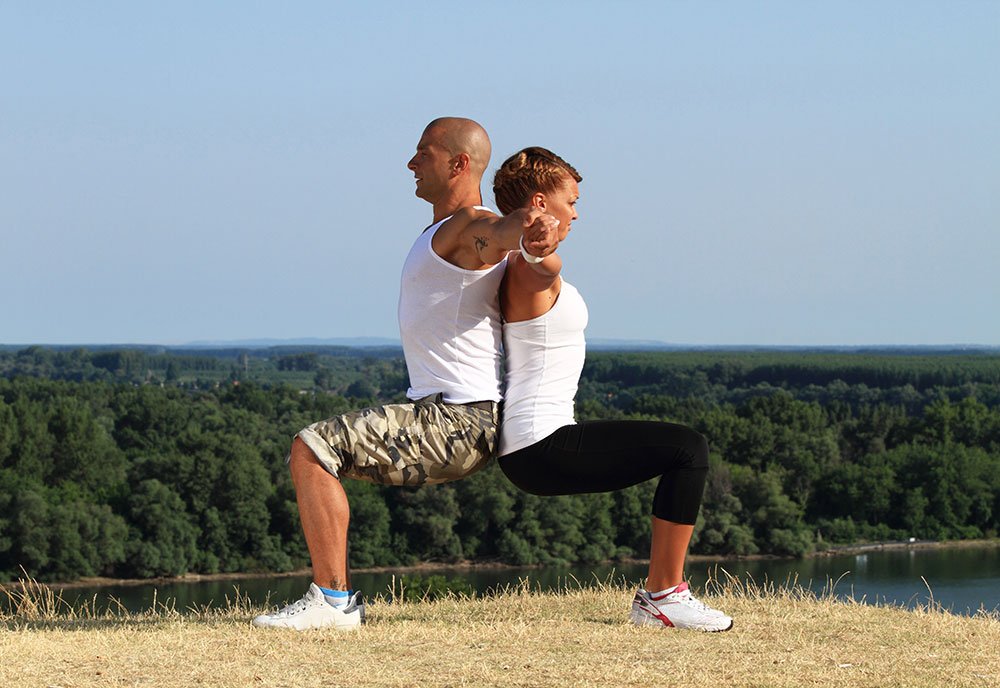
This pose builds trust and strength — physically and within your relationship — and also works on developing your sense of coordination and teamwork.
Even if you and your partner may be of different body sizes and strengths, you will have to work with each other so that you exert equal support for each other throughout the pose.
Face each other in Tadasana to begin. Leave enough space in between you so you can still hold each other’s hands with your arms extended forward.
Hold each other’s hands firmly for safety. If needed, wipe off sweaty hands on a towel before you begin. When you have a solid grip on each other, begin to bend your knees so you both sit in imaginary chairs. Lean back as you sit and prevent each other from falling over backwards with your hands.
Allow yourselves to gaze into each other’s eyes to create a connection between the two of you as you breathe slowly and deeply in this pose.
To add another layer of coordination and trust in this Partner Chair Pose, carefully switch your grip so that you are holding the same hand (your right hand will grip your partner’s right hand). Inhale and open up your left arms to the side and both of you will twist to face your own left hand.
Exhale as you bring your left hand back to center, hold each other’s left hand, and do the same twist with your right arm.
Anuvittasana – Standing Supported Backbend
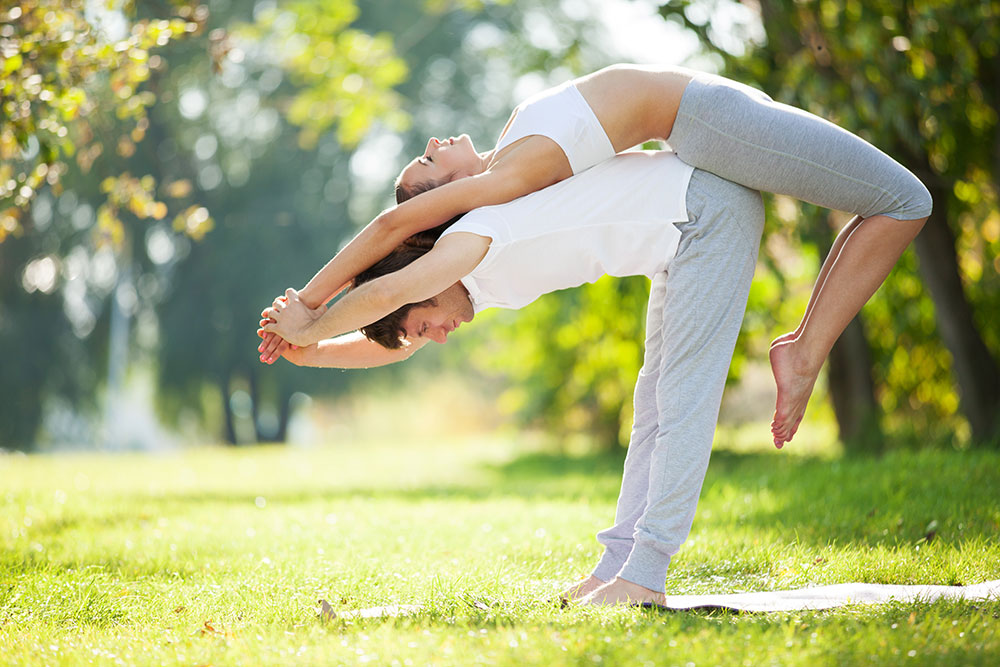
This is another pose that will develop support and strength in your partnership. It is also great for lower back pain and expanding your chest.
Stand to face each other in Tadasana. This time, stand near enough so that you can get a good grip on each other’s elbows. Slightly bend your knees to avoid hyperextension and protect your lower back.
Tilt your heads back and begin to lean backwards. Even as your backbends deepen, continue to lengthen your spine through the crown of your head to prevent compression.
Remember that this yoga pose isn’t about how flexible you are on your own. It’s about supporting each other to breathe in the asana as one. You need to remain open and sensitive to the needs of your partner in this pose and communicate your own needs clearly so you can grow together in this pose in complete safety.
Partner Navasana – Boat Pose
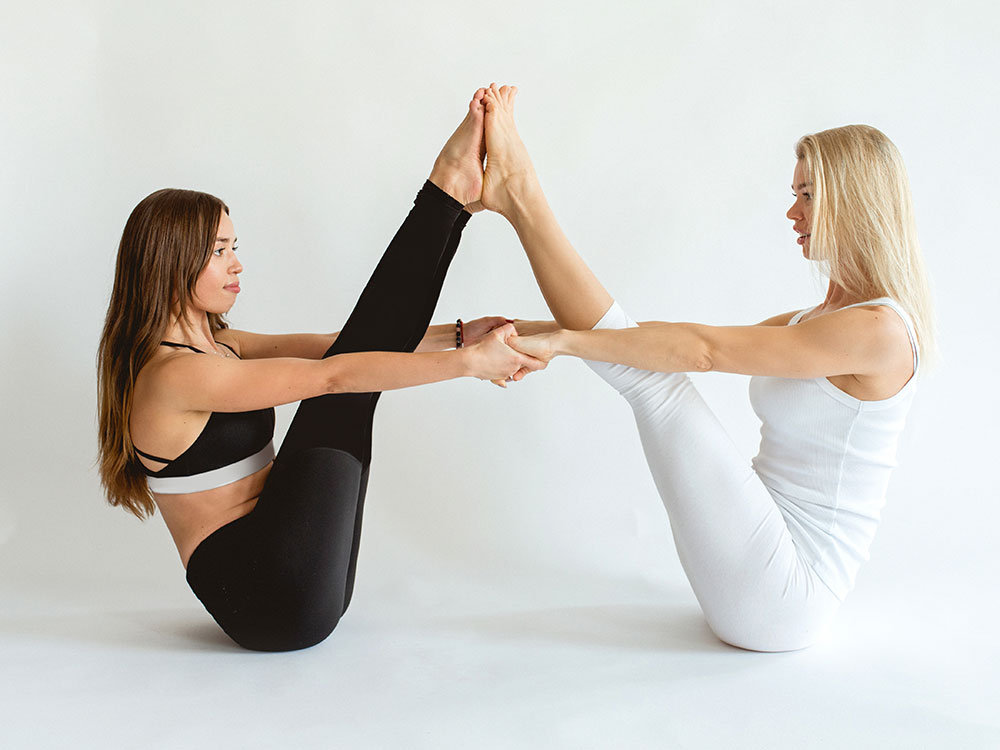
This pose will help you and your partner develop core strength and stability while lengthening and strengthening your hamstrings. You will have to respect each other’s limits and capabilities to find a balance between your bodies to support each other to hold the pose in a comfortable way.
With regular Boat Pose, you have to navigate a comfortable spot on your sit bones to balance on. This partner version could either make it easier or more challenging because you will have each other to support while finding that balance.
Sit to face each other with your knees bent and grasp each other’s hands either from the outside or inside of your legs. Grasping from the inside will allow a wide-legged Navasana variation.
Move one leg at a time. Connect the sole of your right foot with the sole of your partner’s left foot. As you straighten that leg, also connect the other feet and straighten the other leg too so that both legs are extended upwards to form an inverted letter “A” with your legs and arms.
Partner Savasana – Corpse Pose
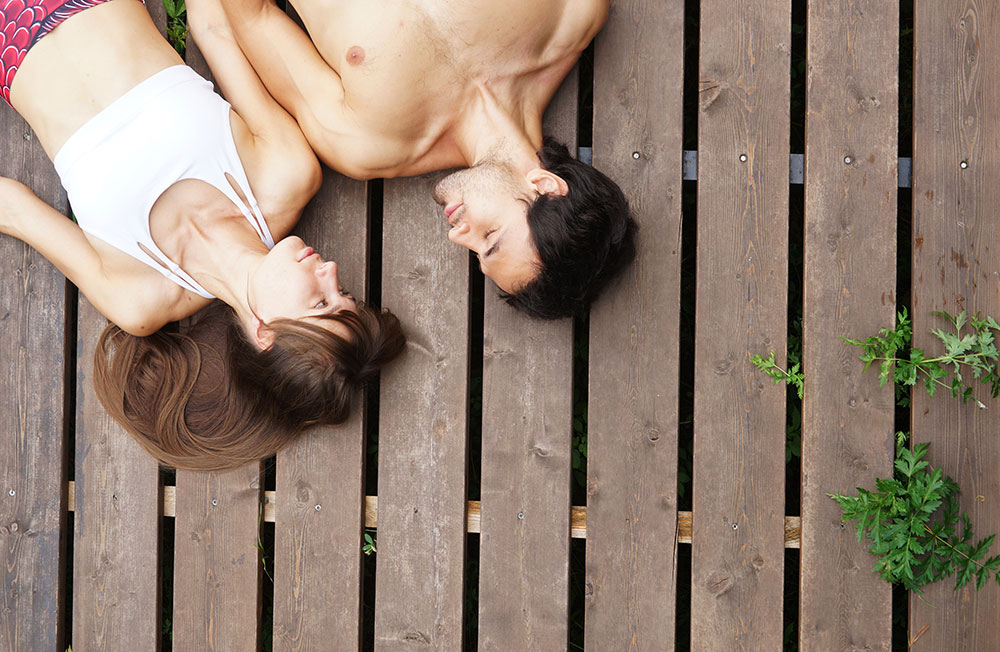
Even Savasana, or your Final Resting Pose in this yoga practice for couples can help develop intimacy.
Lay on your mat with your head towards your partner’s feet (and their head towards yours). As you settle into Savasana, allow your partner to rest their hand on your belly and your hand to rest on their belly. Place your hand over their hand, and let them place their hand over yours as well.
Depending on your height difference, you may have to shuffle up or down to be able to place your hands on each other’s abdomen comfortably.
Lay here and completely relax into each other’s breath rhythm. Allow yourself these final moments of silence in your partner yoga practice to take in all the physical and emotional benefits of yoga as a couple.
What's Your Reaction?
Susan views the world through a lens of spirituality, health, and compassion. Her positive outlook on life shines through her writing, which is heavily focused on yogic living, meditation, and conscious eating.






